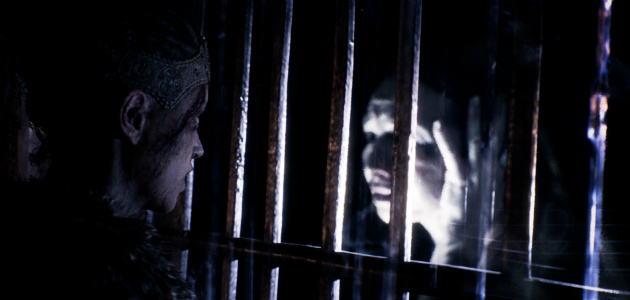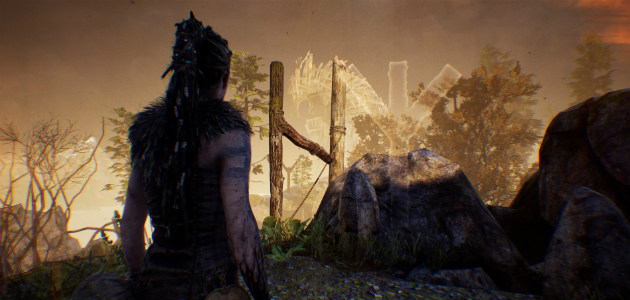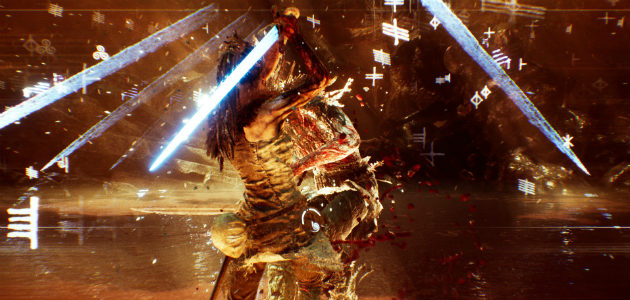Wot I Think – Hellblade: Senua's Sacrifice
Difficult to play
The voices won’t stop. They’re whispering in my ear, gnawing at my skull from all angles. “Turn back”, one says. “They’re watching you”. “She falls for their tricks every time,” says another, cackling while Senua screams. More than once during Hellblade: Senua’s Sacrifice [official site] I had to fight the urge to rip the headphones from my ears. As a portrayal of how harrowing it is to live with psychosis it undoubtedly succeeds, and it uses Senua’s illness as a route into an excellent eight-hour story about love and loss. But, sometimes, especially in its combat segments, it’s also difficult to play for the wrong reasons.
Senua, a warrior from the Orkney Islands, has left her burned village for hell (or Hel, in the Norse mythology) in the hopes of saving the soul of her murdered dead lover, Dillion. So far, so dark fantasy. Except Senua suffers from psychosis, and the world you visit is a manifestation of her mind.
It’s a beautiful setting, both technically brilliant and visually varied. It shifts around you, Senua’s mind taking you from a flowery meadow one minute to a river of corpses the next before dropping you at the feet of a towering god of fire for a boss fight. It’s cinematic, partly thanks to its total lack of HUD.
Her psychosis comes across in the audio, too. The games uses binaural 3D audio, which means each of the voices in her head sounds like it’s coming from a different direction. Having four or five people shout and whisper at you at the same time, often saying conflicting things, is very uncomfortable – which is the whole point.
And it does more than simply show how psychosis might feel: a lot of the details of the story come from those voices, which add context in moments of action (“she’s not strong enough”) and narration in the down time. They take on personalities, and some of them manifest as visions as well. It’s through Senua’s conversations with these voices that we start to piece together the story.
On the surface, the story of her quest is simple enough, but it develops subtly. The game is full of symbolism, and as you learn more about her past you’re constantly trying to work out what the objects in the world might represent. Is that demon her father? Are those burnt bodies people she knew that died? You’re simultaneously experiencing the story in the moment while piecing together Senua’s backstory, all the while linking it to what it means for her battle with mental illness.
Don’t expect huge plot twists, but the slow drip of exposition adds up to a really involving tale that focuses on a few themes and explores them deeper than most other games dare.
It’s driven by fantastic acting, both from the voice actors and by Senua herself – her terrifying screams and monologues are genuinely affecting, and you can’t help but root for her. The only slightly odd choice is that some of the actors arrive on screen in live-action shots (ie, real life versions of themselves, just blurred a bit) which feels out of place. But overall, it all clicks together.
So, a focus on interesting themes, fantastic visuals, and a story that you actually care about. What’s the catch? Well, most of the game you’re not watching cut scenes or listening to monologues. You’re journeying through the world, solving relatively simple puzzles or cutting down enemies, and both of these are weaker than the narrative.
For most of the puzzles you’re put into a single large zone with a locked door ablaze with runes. To get through to the next area you have to find the corresponding runes in the environment. Generally, this means that you search around for a vantage point, and from that angle objects in the environment will look like the runes you're looking for. The branches of a tree will align to form a cross, for example.
The game throws in a new mechanic here and there to keep the puzzles varied. Sometimes you're met with portals that distort reality. Walking through the portal might repair a destroyed bridge, allowing you to cross, and on the other side of that bridge will be the right spot for you to find a rune. In one puzzle you have to light fires to cast shadows to form the shape of a rune, moving backward and forward between waterfalls that extinguish your torch and fire pits to relight them in the right order to get the job done.
And then sometimes there’s a complete curveball: there’s one memorable section where you’re thrust into darkness, Senua groping forward for a path you can’t see, and it evolves into a tense stealth segment. I wish the game had thrown in a couple more of these surprises and lost a few of the basic rune puzzles, but overall it switches it up just enough to hold your attention.
When you’re not stealth-ing or solving puzzles you’re most likely in combat – the worst bit of Hellblade. It’s pretty to look at but ultimately shallow and repetitive. It revolves around a ‘focus’ mechanic: time your dodges and evades correctly and you’ll build up your focus meter, indicated on a mirror swinging from your belt. Fill it up and you can trigger slow motion, taking the fight to your larger foes and cutting them to bits with a mixture of light and heavy strikes.
When it all comes together it’s a fluid dance, as you bounce between bare-shirted men in headdresses, dodging massive axe blows. But too much time is spent waiting around for that focus to come – sometimes you can’t actually deal any damage without it, so you’re relying on the enemies to attack you first (a bit like the counter mechanic in the Assassin’s Creed games). The enemies lack variety, too: there’s one or two boss fights that are more interesting, but generally you’re up against the same pack of enemies with the same telegraphed combat moves. They’re easy to deal with, but it just takes a frustrating amount of time.
The camera doesn’t help. It snaps to the enemy it thinks you want to fight, which can lead to Senua spinning wildly when she's surrounded. And then in tight spaces the camera will back up against a wall and change angle so all you can see are a crush of limbs as you mash the evade button.
The poor combat affects the pacing of the game, too. Sometimes the combat (especially the boss fights) are accompanied by story segments, which makes them bearable. But sometimes they're not. Hellblade relies too heavily on its swordplay towards the end with protracted combat segments that simply slow the game down right as it's rushing to its conclusion. These longer segments aren't interesting, either: all it does is pour lots of enemies at you, forcing you into the same dodge patterns and combos over and over again.
And – a final fly in the ointment – I had massive technical problems with Hellblade. About halfway through my framerate tanked: it went from a stable 45-50 on Very High settings to 20 or even lower, and stayed like that for most of the rest of the game, kicking back up to 50 or so in places. That’s almost unplayable and at times – especially during combat or particularly dark scenes – I had no idea what was going on.
There’s multiple threads on Reddit and Steam discussing the issue, which seems to affect some players with AMD cards (like me). There’s no immediate fix. Turning down all graphics settings makes no difference (I was still around 20 FPS with everything on Low). For that reason, I can’t recommend AMD users play Hellblade until Ninja Theory patch the problem.
When that patch does come out though – and for everyone else who doesn’t have AMD cards – then Hellblade is well worth buying. Some segments are a slog, and mechanically it's nothing special, but it’s worth battling on to experience the multi-layered story that explores themes that other games daren’t.
Hellblade is brave for tackling psychosis so directly, and braver still for pouring so much of its efforts into its narrative. It’s unlike anything else I’ve played this year, and for that reason it deserves a slice of your time.




